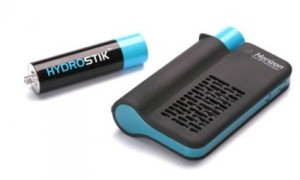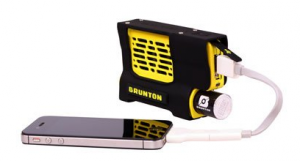 Fuel cells are solid-state power plants. They convert chemical energy (fuels such as hydrogen, natural gas, propane, methanol) into electrical energy in a single electrochemical reaction.
Fuel cells are solid-state power plants. They convert chemical energy (fuels such as hydrogen, natural gas, propane, methanol) into electrical energy in a single electrochemical reaction.
Fuel cells can be scaled in design and manufacturing from the size of a thumbnail to tractor trailer-sized units. In 2014, the most viable market for fuel cells remains stationary distributed power. Beginning in 2015, major automakers such as Toyota, Honda and Hyundai will sell fuel cell electric vehicles. Both stationary and vehicle applications are in early stages of growth.
Micro Fuel Cells: Vision of Personal Power
The more interesting fuel cell application is even more nascent in its market maturity. Micro fuel cells are probably the most overlooked or easily dismissed energy technology on the longer term horizon of energy market transitions beyond 2025. Yet there is nothing more disruptive then the use of portable fuels and micro fuel cells to address issues of energy access (energy poverty). The lofty vision is to reinvent the energy ladder with market solutions that put clean hydrogen-rich fuels and micro fuel cells into the hands of every person on the planet.
Let’s look at the potential paths ahead for this small scale approach to portable fuels and energy conversion.
Micro fuel cell applications by size and application:
- Thumb-sized – a fuel-fed mini ‘power plant’ embedded within an electronic device (e.g. phones, tablets, industrial-grade devices)
- Hand held – a fuel-fed recharger for batteries inside portable devices; portable auxillary for industrial equipment
- Small bread box sized – a fuel-fed auxillary power unit (APU) for vehicles, military, recreational camping, distributed or remote infrastructure
Near Term Market: Premium Portable Power (2014-2020)
The market-ready applications for micro fuel cells are for premium forms of energy acess that frees us from connections to electrical sockets and the grid. People who need reliable energy while at music festivals, camping trips, military excursions. The market demand remains soft but likely to follow the same cost-curve and adoption model of previous disruptive technology platforms.
Companies such as Brunton, Intelligent Energy, MyFC and Neah Power systems sell hydrogen cartridges (usually solid state H2) and micro fuel cell units that can give you power on the go. The cost of ‘refueling’ a portable device ranges across product lines but it a premium to no or low cost of plugging into a wall socket. If you take a longer view on solid state hydrogen storage (e.g. MOFs) and increased output from fuel cell membranes this refueling model starts to look disruptive. In the short term it is a premium portable power solution for recharging batteries within our electronic gadgets.
Mid-term Market: Embedding Fuel Cells – Refueling beats Recharging (2020-2025)
What if we could embed fuel cells within electronic devices? ‘Better batteries’ can only take us so far with portable devices that continue to consume more power. Integrating micro fuel cells within portable electronics would provide clear market signals to manufacturers and portable fuel providers. In this scenario fuel cells replace batteries as the primary source of electricity within portable electronics. We would ‘refuel’ our devices rather than ‘recharge’ them. You could purchase portable fuel packets in any retail setting. Never have to worry about finding a socket to plug into – simply refuel with a new cartridge.
Long-term Disruptive Vision: Personal Power for the Entire Planet – (2025-50)
The long term disruptive vision of micro fuel cells is to reinvent the Energy Ladder by placing clean hydrogen-rich fuels at the bottom of the rung. In this scenario individuals around the world could purchase ‘packets’ of fuels (solid H2; liquid H2 rich fuels) and micro-fuel cells (the power plant) in typical retail setting. In this future we could produce small micro power systems that are sold across retail channels and provide a ‘leapfrog’ option for billions of people seeking an alternative to the ‘grid’.
To arrive at this scenario we would need to see both incremental and breakthrough performance gains. Solid state hydrogen storage via adsorption (not hydrides) would have to deliver on energy and power density. Fuel cell membranes would need to leverage nano-structured materials design for non-precious metal catalysts and improved reduction side reactions that increase electricity output. Even if these capabilities did not arrive until 2030 or 2040 it is still in time to meet the changing needs of a planet that will have doubled its energy demands from 2014.
So that is most simple roadmap for micro fuel cells. Who are the companies that could take us there?
Micro Fuel cell Companies – without commentary and in no particular order!
- Intelligent Energy UPP
- MyFC PowerTrekk
- Brunton
- Horizon Fuel Cells
- Nectar Power
- Neah Power
- Protonex
- MTI Mobion
- Point Source Power – novel ‘base of pyramid’ applications
- Oorja – direct methanol approach
- Trulite
- PowerCell – Sweden
- TMI – contract manufactur of industrial-military grade
*I have not include bio micro fuel cells.
Haters, will hate 😉
If you follow the energy ‘cleantech’ blogger world conversations there is a lot of skepticism over fuel cells and hydrogen. I will not go into the long list of reasons why skepticism is warranted yet short-sighted and lacking in understanding of long-term dynamics of energy market transitions. Nothing can change the energy industry overnight!
The micro fuel cell market is in a nascent stage so shake-outs, failures, and breakouts are all part of this phase of development.
There is no need to write-off or be dismissive about hydrogen or fuel cells.
The energy story is a marathon not a sprint. In addition to talking about the ‘future of solar in 2020’ we need to be able to invest in alternative visions that go beyond 2025 and can carry us through the century. Portable fuels and power systems is critical to the foundation of a 21st century energy marketplace.
But if you are a doubter and keeping score here is a list of companies who have failed, folded or been absorbed:
- Jadoo
- Voller Energy
- Medis Technologies
Why continue to dream of fuel cells when solar costs are dropping?
Solar rooftop panels can only take the world so far. Solar requires Solar’s business model is challenged in a world where people need portable fuels that can satisfy high energy consumption. Solar rooftop is a structural solution to energy demands and requires significant investment in installation and maintenance. Selling portable fuels and micro fuel cells can use existing retail store channels.
Videos – Micro fuel cells
Brunton – direct link
Demonstration
Outdoor Youtube Show Overview
